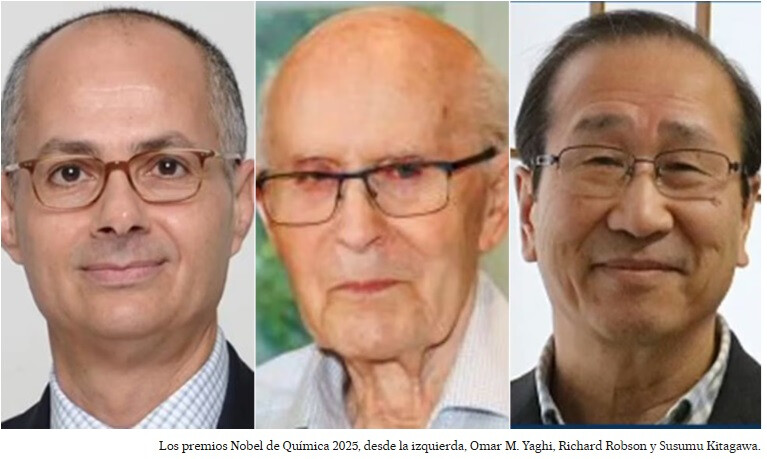
The 2025 Nobel Prize in Chemistry was awarded to three scientists: Susumu Kitagawa (Japan), Richard Robson (United Kingdom), and Omar Yaghi (Jordanian-American). In honoring the innovative molecular structures they developed—Metal-Organic Frameworks (MOFs)—the Royal Swedish Academy of Sciences recognized their contribution to presenting new possibilities for solving various global challenges. MOFs are hailed as a new material with limitless application potential, from absorbing pollutants to drug delivery.
The Birth and Development of the 'Molecular Hotel'
Heiner Linke, Chair of the Nobel Committee for Chemistry at the Royal Swedish Academy of Sciences, described MOFs as "a completely new material with large empty spaces inside, like hotel rooms that guest molecules can move in and out of." MOFs use metal ions as the scaffolding and long organic molecules as the linkers to form a robust, yet porous, three-dimensional network structure, much like a building's framework. A key feature of this structure is the ability to design the size and chemical properties of the internal pores as desired by combining metal and organic components.
The journey of MOF development began in 1989 when Richard Robson created crystals with cavities by combining copper ions and organic molecules, but the initial structures were fragile and easily broken. Subsequently, between 1992 and 2003, Kitagawa and Yaghi independently conducted research to grant this structure robustness. Professor Kitagawa of Kyoto University demonstrated that gas could move in and out of the MOF's interior, predicting the possibility of flexible structures with new characteristics. Professor Yaghi of the University of California, Berkeley, created highly stable MOF structures and established methods for rationally designing the materials to suit specific applications. In 1995, Yaghi published a 2D material structure combining copper or cobalt, which maintained stability up to 350 degrees Celsius and was given the name Metal-Organic Framework (MOF).
Limitless Applications for Solving Global Challenges
The discoveries of these three scientists laid the foundation for developing tens of thousands of functional MOFs, which are now being recognized as solutions to numerous societal problems. MOFs show revolutionary potential in gas storage and separation, utilizing their vast surface area and precisely controllable pore size.
Environmental Cleanup: They are used to extract water from desert air, remove cancer-causing chemicals like PFAS from water, and break down pharmaceutical residues remaining in the ocean, rivers, and groundwater.
Energy and Climate Change Response: Utilizing their property of adsorbing gas molecules, MOFs can capture carbon dioxide (CO2), the main culprit of global warming, or be used as a high-efficiency storage medium for eco-friendly energy sources like hydrogen (H2) and methane.
Medicine and Life Sciences: MOFs have higher biocompatibility than inorganic porous materials like zeolites, allowing them to be applied in drug delivery systems that transport and release drugs to specific sites in the body and are then easily excreted.
Advanced Technology: They have the potential to accelerate catalytic reactions or contribute to the field of quantum technology by developing materials with magnetic, electrical, and optical properties through Quantum MOFs, which are regarded as a technology of the future.
MOF research is currently active worldwide, including in South Korea, and its utility is already being proven in daily life through commercialization in products like air purifier filters. Daniel Maspoch, a researcher at the NanoScience Institute, highly praised the value of their discovery as "a paradigm shift in chemistry," while Felipe Gandara, a researcher at the Madrid Institute of Materials Science, lauded them as "pioneers in designing networks with various sizes of pores and specific chemical functions."
Another Nobel Story
This Nobel Prize in Chemistry includes a total cash award of 11 million Swedish Krona (approximately 1 million Euros) to be shared among the three recipients. Notably, Omar Yaghi, who was born to an illiterate Palestinian refugee family and moved to the US, achieved success in the scientific community. In his acceptance speech, he emphasized the "equalizing power" of science, stating, "If you learn how to control matter at the level of atoms and molecules, the potential is huge." Professor Kitagawa still considers MOF research "fun," and his "dream" is to separate air or water into their constituent parts using only renewable energy and convert them into useful substances. MOF research is expected to continue to contribute significantly to a sustainable future for humanity through ongoing innovation.
[Copyright (c) Global Economic Times. All Rights Reserved.]




























